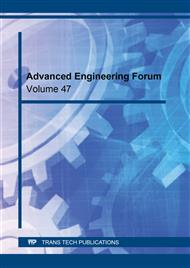[1]
B. L. Barhoi, R. C. Borah, S. Singh, Natural Convection in a Nano-Fluid Filled Square Enclosure, Key Engineering Materials. 847 (2020) 114-119.
DOI: 10.4028/www.scientific.net/kem.847.114
Google Scholar
[2]
F. Shaik, V. K. Domakonda, Numerical Study on Natural Convection of Alumina-water Nanofluid in a Square Cavity with Two Localized Heat Sources on Adjacent Surfaces, PeriodicaPolytechnica Mechanical Engineering. 65 (3) (2021) 217–228.
DOI: 10.3311/ppme.16748
Google Scholar
[3]
A. I. Alsabery, A. J. Chamkha, H. Saleh, I. Hashim, Natural Convection Flow of a Nanofluid in an Inclined Square Enclosure Partially Filled with a Porous Medium, Scientific Reports. 7 (1) (2017) 1-17.
DOI: 10.1038/s41598-017-02241-x
Google Scholar
[4]
A. I. Alsabery, M. A. Sheremet, A. J. Chamkha, I. Hashim, MHD convective heat transfer in a discretely heated square cavity with conductive inner block usingtwo-phase nanofluid model, Scientific reports. 8 (1) (2018) 1-8.
DOI: 10.1038/s41598-018-25749-2
Google Scholar
[5]
I. A. Alsabery , T. Tayebi , A. J. Chamkha, I. Hashim, Effects of Non-Homogeneous Nanofluid Model on Natural Convection in a Square Cavity in the Presenceof Conducting Solid Block and Corner Heater, Energies. 11 (10) (2018) 2507.
DOI: 10.3390/en11102507
Google Scholar
[6]
A. Bouras, D. Taloub, M. Djazzar, Z. Driss, Natural convective heat transfer from a heated horizontal elliptical cylinder to its coaxial square enclosure, Mathematical Modelling of Engineering Problems. 5 (4) (2018) 379-385.
DOI: 10.18280/mmep.050415
Google Scholar
[7]
A. Bouras, D. Taloub, Z. Driss, Effect of Rayleigh number on internal eccentricity in a heated horizontal elliptical cylinder to its coaxial square enclosure, International Journal of Applied Mechanics and Engineering. 25 (3) (2020) 17-29.
DOI: 10.2478/ijame-2020-0032
Google Scholar
[8]
A. Bouras, D. Taloub, Numerical investigation of natural convection phenomena in uniformly heated trapezoidal Cylinder inside an elliptical Enclosure, Journal of Computational Applied Mechanics (JCAMECH). 50 (2) (2019) 315-323.
Google Scholar
[9]
M. F. Al-Asad, M. N. Alam, Hijaz, A. M. M. A. Sarker, M. D. Alsulami, K. A. Gepreel, Impact of a closed space rectangular heat source on natural convective flow through triangular cavity, Results in Physics. 23 (2021) 104011.
DOI: 10.1016/j.rinp.2021.104011
Google Scholar
[10]
S. A. Hossain, M. A. Alim, S. K. Saha, A Finite element analysis on MHD free convection flow in open square cavity containing heated circular cylinder, Am. J. Comput. Math. 5 (1) (2015) 41-54.
DOI: 10.4236/ajcm.2015.51003
Google Scholar
[11]
M. S. Hossain, M. A. Alim, L. S. Andallah, Numerical simulation of MHD Natural convection flow within porous trapezoidal cavity with heated triangular obstacle, I. J. Comput. Math, 6 (6) (2020) 166.
DOI: 10.1007/s40819-020-00921-3
Google Scholar
[12]
F. Z. Bensouici, S. Boudebous, Mixed Convection of Nanofluids inside a Lid-Driven Cavity Heated by a Central Square Heat Source, F.D.M.P. 13 (3) (2017) 189-212.
Google Scholar
[13]
N. Alsedais, Natural Convection over Two Super ellipse Shapes with a Porous Cavity Populated by Nanofluid, Energies. 14 (2021) 6952.
DOI: 10.3390/en14216952
Google Scholar
[14]
M. Sheikholeslami, M. Gorji-Bandpy, D. D. Ganji, S. Soleimani, S. M. Seyyedi, Natural convection of nanofluids in an enclosure between a circular and a sinusoidal cylinder in the presence of magnetic field, International Communications in Heat and Mass Transfer. 39 (9) (2012) 1435–1443.
DOI: 10.1016/j.icheatmasstransfer.2012.07.026
Google Scholar
[15]
L. Zhang, Y. Hu, M. Li, Numerical Study of Natural Convection Heat Transfer in a Porous Annulus Filled with a Cu-Nanofluid, Nanomaterials. 11 (4) (2021) 990.
DOI: 10.3390/nano11040990
Google Scholar
[16]
M. El Abdallaoui, M. Hasnaoui, A. Amahmid, Numerical simulation of natural convection between a decentered triangular heating cylinder and a square outer cylinder filled with a pure fluid or a Nano fluid using the lattice Boltzmann method, Powder Technology. 277 (2015) 193-205.
DOI: 10.1016/j.powtec.2015.02.042
Google Scholar
[17]
H. S. Majdi, A. M. Abed, L. J. Habeeb, Mixed Convection Heat Transfer Of Cuo-H2o Nanofluid In A Triangular Lid-Driven Cavity With Circular Inner Body, Journal of Mechanical Engineering Research and Developments. 44 (1) (2020) 164-175.
Google Scholar
[18]
M. A. Sadiq, A. I. Alsabery, I. Hashim, MHD Mixed Convection in a Lid-Driven Cavity with a Bottom Trapezoidal Body: Two-Phase Nanofluid Model, Energies. 11 (2018) 2943.
DOI: 10.3390/en11112943
Google Scholar
[19]
C. S. Kim, K. Okuyama, J. D. L. M. Fernandez, Performance evaluation of an improved particle size magnifier (PSM) for single nanoparticle detection, Aerosol Science and Technology. 37 (10) (2003) 791– 803.
DOI: 10.1080/02786820300913
Google Scholar
[20]
A. Nada, Z. Masoud, , A. Hijazi, Natural convection heat transfer enhancement in horizontal concentric annuli using nanofluids, International Communications in Heat and Mass Transfer. 35 (5) (2008) 657– 665.
DOI: 10.1016/j.icheatmasstransfer.2007.11.004
Google Scholar
[21]
M. Khentoul, R. Bessaïh, Numerical Simulation of Nanofluid Cooling Enhancement of Three Fins Mounted in a Horizontal Channel, Journal of Heat Transfer. 138 (2016) 091002.
DOI: 10.1115/1.4032946
Google Scholar
[22]
J. C. Maxwell, A Treatise on Electricity and Magnetism, vol. II, Oxford University Press, Cambridge, UK, 1873, p.54.
Google Scholar
[23]
S. M. Aminossadati, B. Ghasemi, Enhanced natural convection in an isosceles triangular enclosure filled with a nanofluid, Computers and Mathematics with Applications. 61 (2011) 1739–1753.
DOI: 10.1016/j.camwa.2011.02.001
Google Scholar


